Length: ~270km (165mi)
Duration: 2 – 4 days. You can also ride it in 1 day, of course. However the scenery is pretty nice and it would be a shame to ride through the whole valley like crazy.
Start: The track starts south of Karakul lake and you have to leave the main road to the right. There are no signs and only a few tracks heading westwards. After a few kilometers they converge to a single dirt track and you know, that you are on the right path.
Difficulty: Depending on the weather and the season, the track can be everything between medium difficulty to impassable.
It has lots of water crossings, very rocky parts, dried out rivers with large pebbles and boulders and steep sections without guardrails. Some rivers might be only passable in the morning time before the snow in the higher mountains starts to melt.
Special preparations: Its important to bring enough food. Fresh water is available, but you should have a water filter. Sometimes you can drink it without filtering. You need gasoline for at least 400km (250mi). The last petrol station is in Sary Tash (Kyrkyzstan) and the next one in Rushan or Khorugh. This is how it was 2018. If you are not yet used to altitude, it is better riding south to north. Coming from the north, the altitude gains rapidly – Osh (950m), Sary Tash (3150m), Border (4200m) and first part of Bartang Valley (~4000m)
How was it?
The 17 km long road between the kyrgyz and the tajik border can become impassable depending on the weather. It is a steep mountain pass mainly dominated by soft dirt that turns into deep mud after some rain. Fortunately we have sunshine and a great view. We are riding with Robin, a british Biker, we already met several times on our trip before. The pass is just below 4300m and the tajik border is still at almost 4200 m. Miriam ist not doing well, due to the altitude.
We are the only people at the tajik border building and we hope for a quick entry. It was a misconception. The tiny customs department has no computers and everything has to be handwritten into books. Not only does it take forever, we also have to pay lots of fees, that apparently seem to differ, depending on your negotiating skills. They even force us to pay for a desinfection of our bikes. Means an unmotivated guy sprays some stuff (propably water) on our completely muddy tires for a few seconds. Although the cleanliness condition of our bikes hasn’t changed at all (what a surprise), they charge us 5 dollars each. Furthermore we have to pay something like registration fee and road tax fee.
After we are finally allowed to continue and the barrier has opened, two man at the next building are already waving. They try to tell us, that we have to pay for even more stuff. As we are already quite pissed, we completely ignore them and just continue riding. Nobody follows us while we are driving down the pass to the village of Karakul.
The huge, blue Karakul Lake lies at 4000m altitude. We drive to the south side of the lake and try to find the entrance to the Bartang Valley. We have three different GPS devices and they all show a different non-existent road.
Therefore we simply decide to follow a few sparse tracks offroad. After a few kilometers they led us to a single dirt road. This part of the route is not really a valley yet. It rather is a desert-like plateau surrounded by snow-capped mountains.
After many kilometers of dust we reach a small stream. The river bed it is green and there is beautiful vegetation right next to it. I looks quite strange, because just a few steps of the little creek, is only dust and rocks left – like on the moon. It is getting late and we decide to pitch our tents on one of these green areas. A nasty wind starts blowing and after the sunset it gets uncomfortably cool. Not surprising since our night camp is at around 4000m.
The next day we pass a yurt and an ordinary built stone house, surrounded by some sheeps. The owners are super nice and want to invite us for lunch. As we are not in a hurry anyway, we are very pleased about the invite. The base of the hut is built with stones and mud – the roof with wood and straw. We have no idea where they got the wood from – we havent seen a single tree so far in this country. A little two days old lamb is jumping around in the house. Outside it would have been to harsh for the little creature to survive.
We get offered fried bread, butter, cookies, kefir, plums, a huge bowl of chunks of meat and cay tea, of course. It is a completely different world and really impressive to see, how people can live with almost nothing in the middle of nowhere. Unfortunately none of them can speak english, so having a conversation is tough. We stay around 1 hour before we say goodbye and finally offer them some money for the generous meal. They have never asked for money, but they can certainly use it.
A few kilometers further we reach the edge of a large valley with a gigantic river bed – the Bartang. This time of the year it does not carry that much water and it consists of many small streams winding through the valley like veins. A steep track leads quite adventurously down to the river bed. Now we have arrived to the actual Bartang Valley. It already is late afternoon and we find a good place to set up our camp in a slightly sheltered area between shrubs right next to the river. The river carries a lot of sand and dirt, which makes filtering quite exhausting, but we still need some water to cook. Robin brought some vodka and starts mixing cocktails with vitamin tablets, vitamin C powder and saccharin. He calls them a Bartang Screw Driver. Sounds gruesome at first, but it is a real outdoor cocktail at least. We go to bed early.
After breakfast the next morning the route follows the Bartang river. The little rocky track is almost at river level and it leads often right between massive scree slopes on one side and the savage river on the other side. Depending on the water level, the road sections are partially flooded or buried by landslides. This is usually not big deal on a motorcycle, but it can happen really quickly, that it is completely impassable with a car.
We face more and more water crossings and very often you don’t see the ground anymore. Robin wears high, waterproof motorcycle boots and was therefore declared as our test subject. He has to wade though the water to check the depth and ground condition in the beginning. Later in the day we became too lazy and also got a better feeling for it. So usually we just ride on hoping for best luck. The water is damn cold and Tobi’s biggest fear is, that Robin drops his massive 1200GS in one of the river crossings. That would have meant to touch the freezing water and get the bike up again. Luckily none of the bikes fell over in a river.
After a while we reach the first small village of Gudara at about half of the Bartang Valley road. Some other travellers told us before, that you might have to pay a mysterious fee there. Therefore we decide not to stop at this place. A few men are looking at us, but we just continue while greeting friendly. Nobody tries to stop and charge us.
We left the most remote part of Bartang Valley behind us now. From here we regularly pass small houses. Nevertheless, the landscape remains incredibly exciting and after almost every curve you want to stop and take new photos.
The river gradually cuts deeper into the landscape and we drive more and more in a gorge. Every now and then you briefly leave the river and ride a small pass to finally return to the river on the other side. There are no guardrails, the slopes are extremely steep and the track is still very rocky. The Bartang river became a gigantic torrent and is not a normal river anymore. If you get off the road here, it is most likely the last thing you did.
In Shujand we take a short break and talk to some local kids, that want to test their english skills. Miriam’s face is totally covered in dust and good for many laughs. After four days we finally reach the end of the Bartang Valley. We are back in civilization and it feels like we have been in isolation for weeks. Suddenly everything seems very busy and crowded.
We leave Bartang Valley and turn left to follow the main road towards Khorugh, the capital of the Pamir region. A friendly policeman offers Miriam his drinking water to wash her dusty face at a police checkpost a little later. She has to scrub it for about 5 minutes until he is satisfied with the cleaning result. He even gives us two loaves of bread as a farewell. Maybe we are looking starved somehow? The rest of the route to Khorugh we only ride with one hand most of the time. There are so many locals waving and greeting nonstop.
Conclusion: Bartang Valley is for sure one of the worlds best offroad adventure rides. The landscape is just absolutely breathtaking. The road conditions can be challenging, but they also vary a lot. If you choose the right season and love adventurous riding, the whole route is a pleasure. There are no shitty parts with long distances of mud or deep sand. We definitely hope to come back one day…

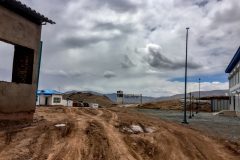
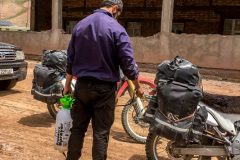
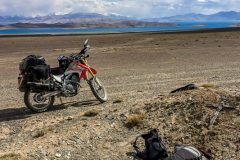
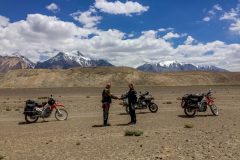
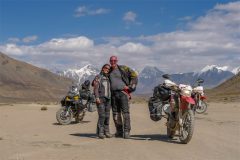
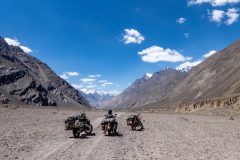
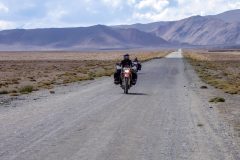
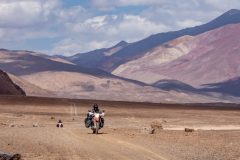
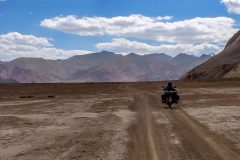
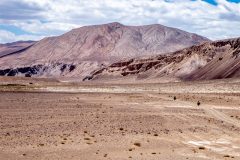
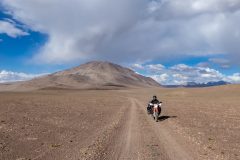
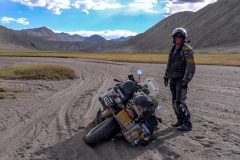
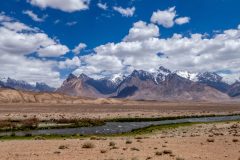
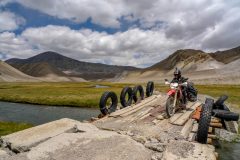
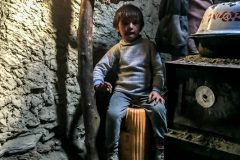
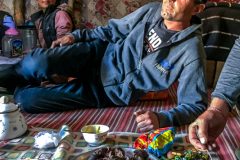
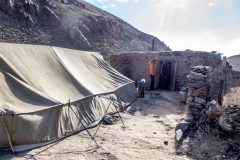
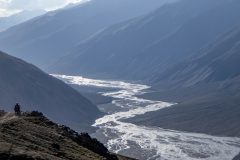
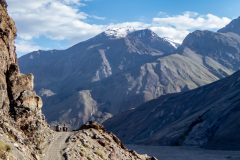
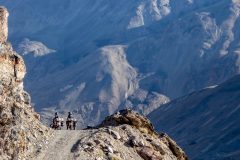
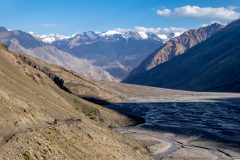
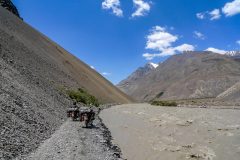
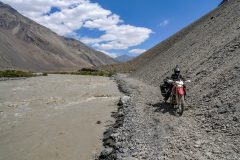
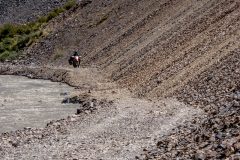
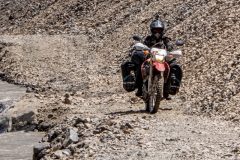
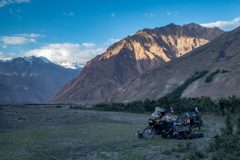
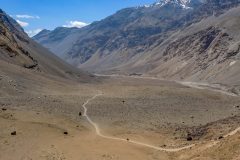
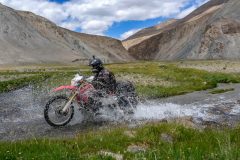
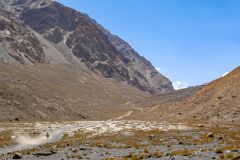
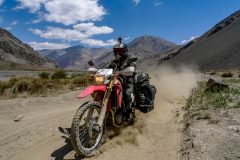
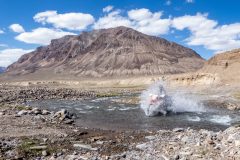
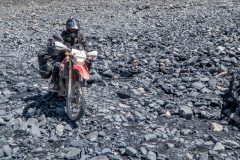
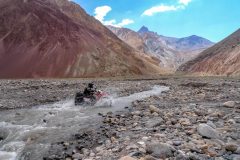
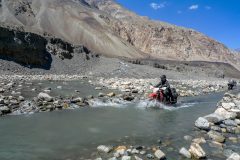
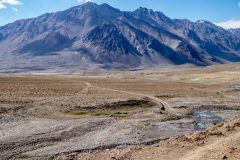
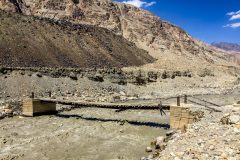
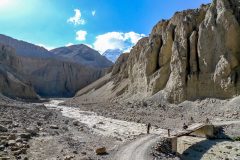
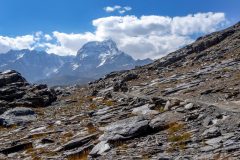
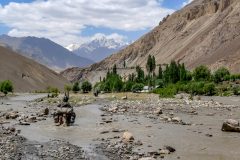
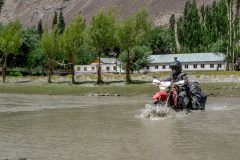
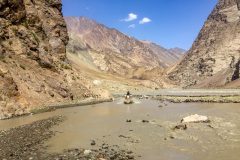
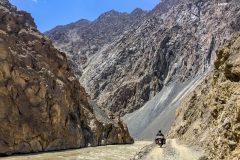
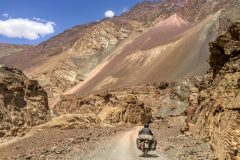
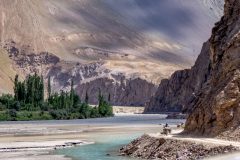
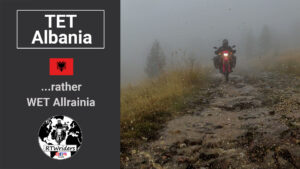
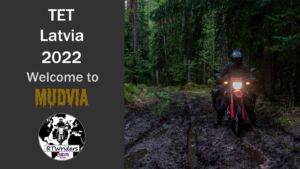
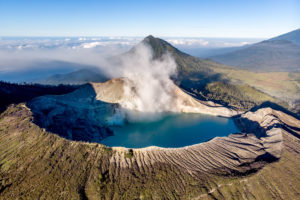

Fantastic ! and lovely pictures. Thanks for sharing and help us to follow our dreams !
Thanks Andre, Bartang is for sure a real Dream ride.